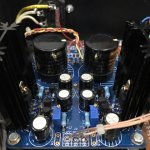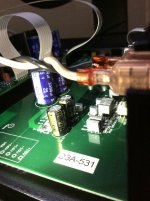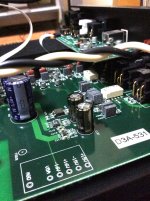Yep, this Taiwan 98 is so different than everything I made doesn't go as far my previous setup with the S1 ! Different sounding for sure !
@ Abrax : Dunno, it's way above of my understanding.
@ Abrax : Dunno, it's way above of my understanding.
Last edited:
Hi to all,
What power supply topology do you use for your AD844 or like stage please ... then your buffer stage?
Doss it Worth to have a poll to see if there is a better one for such I/V stage and our ld chips: PCM1704, AD1862/5, TDA15xx, PCMxx, etc ?
What power supply topology do you use for your AD844 or like stage please ... then your buffer stage?
Doss it Worth to have a poll to see if there is a better one for such I/V stage and our ld chips: PCM1704, AD1862/5, TDA15xx, PCMxx, etc ?
Eldam
I use two Kubota dual discrete regulators for the ad844 + buffer and the tda1541a + wm8804 receiver. The ad844 share the supply with the jfet buffer. This is much better than lm317 and lm337. I also find lt108x sound worse than lm317 if dropped into the place of lm317.
I have used several low noise regulator chips for other dacs lt3080, lt1963, lt1763 and lt3040 (the last one made by diyinhk, very impressive spec). They are quite good compared to lm317/337. But I found the kubota regulator to sound subjectively very good.
I use two Kubota dual discrete regulators for the ad844 + buffer and the tda1541a + wm8804 receiver. The ad844 share the supply with the jfet buffer. This is much better than lm317 and lm337. I also find lt108x sound worse than lm317 if dropped into the place of lm317.
I have used several low noise regulator chips for other dacs lt3080, lt1963, lt1763 and lt3040 (the last one made by diyinhk, very impressive spec). They are quite good compared to lm317/337. But I found the kubota regulator to sound subjectively very good.
Attachments
For bypassing the ad844 chips I use 2x Nichicon muse kz 22uf near to the supply pins, one for + and one for - supply (no film cap or ceramic cap).
Thanks Quantran.
I use the discrete regs from Audial on the AYA 2 . For the front end I use TS7A regs from Mravica. But I subjectivly don't like the X7R ceramic smd outputt caps despite the excellent inductance due to the small size : two reasons: They give often a too climby sounding signature than I can check also with headphones. And often such regs are specified to be loaded with a precise amount of capacitance and unfornatully the pcbs have big decoupling caps at the power plugs for those external power supply reg boards !
The I/V stage and buffer outputt stage will sound different with different supplies on the digital front end, despite FIFO and isolator ! (for me its Wave I/O + IanCanada's stuffs + Pi3 with uf-l plugs board to come)
I use the discrete regs from Audial on the AYA 2 . For the front end I use TS7A regs from Mravica. But I subjectivly don't like the X7R ceramic smd outputt caps despite the excellent inductance due to the small size : two reasons: They give often a too climby sounding signature than I can check also with headphones. And often such regs are specified to be loaded with a precise amount of capacitance and unfornatully the pcbs have big decoupling caps at the power plugs for those external power supply reg boards !
The I/V stage and buffer outputt stage will sound different with different supplies on the digital front end, despite FIFO and isolator ! (for me its Wave I/O + IanCanada's stuffs + Pi3 with uf-l plugs board to come)
Last edited:
This is a pic of the regulators used for belcanto DAC3 output buffer. I can see that they use nichicon muse kz after the regulator chip (I can see LT1763 for positive rail). You should try this cap here. The sound is very organic. If you look at other parts inside the belcalto dac you can see the designer is very serious about part selection.
I have replaced the muse kz on the supply pin of tda1541 chip with blackgate. The sound is brighter with black gate and nicer tone but not a huge difference compared to nichicon muse kz (in a power supply position)
I usually find that using film cap in parallel with high quality electrolytic degrade the sound compare to just using the good electrolytic only.
I have replaced the muse kz on the supply pin of tda1541 chip with blackgate. The sound is brighter with black gate and nicer tone but not a huge difference compared to nichicon muse kz (in a power supply position)
I usually find that using film cap in parallel with high quality electrolytic degrade the sound compare to just using the good electrolytic only.
Attachments
Ah thanks, I can try, I have tons of caps and all the KZ (I have also the bug of the caps... and it's a usefull bug to find the equilibrium of the whole hifi chain ! Hard to find an universal setup with separate elements in a Hi-FI !). I found a huge difference between the BG Std, then BG N & NX (brighter) and KZ ! I like some Pan FR and FC for the TDA1541 main PS... and zero ceramic caps around the TDA chip (it sounds harsch : maybe due to the internal layout of the TDA1541A... I don't know !)
Caddock 132 as I/V resistor ??? You may try the Pan FC 3300/25V instead the blue of the board: this FC is an excellent cap which is often give positiv sounding result !
ok--- I stop with the bug of the caps ! Totally OT !
Caddock 132 as I/V resistor ??? You may try the Pan FC 3300/25V instead the blue of the board: this FC is an excellent cap which is often give positiv sounding result !
ok--- I stop with the bug of the caps ! Totally OT !
Last edited:
Caddock 132 as I/V resistor ??? You may try the Pan FC 3300/25V instead the blue of the board: this FC is an excellent cap which is often give positiv sounding result !
This dac is not mine, it's the stock condition. It uses caddock 132 through out the analoge stage including i/v the filter and output buffer. It uses LT1468 opamps. The dac chip is BB pcm1792
I have used Pan FC in some other DAC before and found them neutral sounding. Muse KZ is slightly warmer. All black gate caps have special sonic character. I am using black gate N as output cap for my tda1541 dac.
yep the BG N are magic here, even more neutral than MKP ! I finally decided to trim to zero the opa861 I/V stage to avoid output caps !
Totally agree with your findings Quan.
Be it linear or Shunt regs I myself find
that it's circuit specific. Like the Buf 03
that I've built tried shunts, Lt series
& lm 3 series , all of them sound different
but somehow the Lm 317/337 sounded
best so I embarked on building a
supply that I came across in Niam forums.
it uses 2 regs per rail with one acting as
a constant current source. Now this reg
really sounds very very good with Buf 03
If I dare say very organic not nasty sibilance
etc. That Kobuta regs that your using also
got me curious. Will try it out some time
Cheers & thks for sharing
Be it linear or Shunt regs I myself find
that it's circuit specific. Like the Buf 03
that I've built tried shunts, Lt series
& lm 3 series , all of them sound different
but somehow the Lm 317/337 sounded
best so I embarked on building a
supply that I came across in Niam forums.
it uses 2 regs per rail with one acting as
a constant current source. Now this reg
really sounds very very good with Buf 03
If I dare say very organic not nasty sibilance
etc. That Kobuta regs that your using also
got me curious. Will try it out some time
Cheers & thks for sharing
......... Like the Buf 03
that I've built tried shunts, Lt series
& lm 3 series , all of them sound different
but somehow the Lm 317/337 sounded
best so I embarked on building a
supply that I came across in Niam forums.
it uses 2 regs per rail with one acting as
a constant current source. Now this reg
really sounds very very good with Buf 03
If I dare say very organic.......
That's interesting. With the BUF-03 burning loads of current in A-class, a constant current regulated supply kind of makes sense.
Please can you share the design and implementation details?
so i know this is 844 thread but can u parallel 861 like you do with 844?
I've done this. 3 per channel. The bottom line is it didn't work as you expected. The high sounds like cut-off, but the mid was very smooth though.
so i know this is 844 thread but can u parallel 861 like you do with 844?
Haven't thought about that question, but the first that comes to mind is why would you do it? I can see why with the 844 since it runs low current in the transconductance stage, on the 861 you can simply just turn it up via resistor fitted to pin 1.
Others might have opinions on this? I would be interested to know if there is indeed an advantage.
Cheers, Joe
did the bass increase?
I'm afraid not. I switched back and like the tonal balance of single opa861. However, it's interesting to hear the difference.
Haven't thought about that question, but the first that comes to mind is why would you do it? I can see why with the 844 since it runs low current in the transconductance stage, on the 861 you can simply just turn it up via resistor fitted to pin 1.
Others might have opinions on this? I would be interested to know if there is indeed an advantage.
Cheers, Joe
Hi Joe,
I'm no expert on this. I heard people stacking AD844's for lowering the input impedance. I'm not sure if this also applies to OPA861. Maybe I didn't do it right, simply stacking 861's do affect the tonal balance to certain degree.
Poting
Hi Joe,
I'm no expert on this. I heard people stacking AD844's for lowering the input impedance. I'm not sure if this also applies to OPA861. Maybe I didn't do it right, simply stacking 861's do affect the tonal balance to certain degree.
Poting
In the 844 you have two parts, you have the OTA front-end and in the 844 it runs at a fixed current and I estimate it might be only 2mA. By stacking the 844, the OTA has a lot more current, not just the other part, the buffer. In the 861 you can set it by a single resistor and easily run 3-4 times the current through the OTA part.
Mind you, the 861 is really meant for low -/+5V operation and the 844 can handle -/+15V and a bit more OK. So there are more variables there.
Cheers, Joe
- Home
- Source & Line
- Digital Line Level
- Using the AD844 as an I/V


